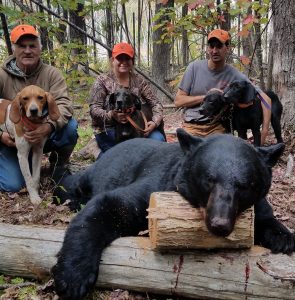Tips for Bear Hunters

By John Floyd
In recent years, the smartphone and social media have by far saved more bears during the bait season than any other factor. No matter how emphasis I put on this, I still have clients, season after season, getting caught banging away on their phones instead of being still, focused and quiet.
Black bear season in Maine is right around the corner. If the pattern holds true this year, we may be in for a tough start to the bear over bait season. Last year, the shortage of natural food sources resulted in some of the hottest bait season action we have seen in years. This year however, we may see the flip side of that. Every year as I ready for the coming season, I always take care to pay attention to the status of natural food sources and rainfall history and predictions. This not only helps to determine if I need to modify my bait selection for a particular year, it also helps in determining if some bait sites will need to be moved or modified.
Natural Foods First
It’s been my experience that when we have an abundance of natural food sources and mast crops, bears will always seek those sources first. As those sources become depleted over the fall, the bait sites usually start to heat up. I’ve been noticing the berries coming in at a healthy clip and many of the trees on a few of the beech ridges I hunt are displaying a nice crop of beechnuts. Since black bears in Maine are well-known for their appetite for berries and beechnuts, I believe hunters taking to their stands in the first couple of weeks of the season will need to be extra prudent in order to fill their tag. Here are a few of the most common mistakes I see when guiding clients who don’t connect with a bear.
In recent years, the smartphone and social media have by far saved more bears during the bait season than any other factor. No matter how emphasis I put on this, I still have clients, season after season, getting caught banging away on their phones instead of being still, focused and quiet. It is magnified when a group of hunting buddies are all out on stand and cannot keep from texting each other about what they are or are not seeing. Trust me on this; the time for social media posts and your smartphone is after the bear is wearing your tag.
Second Mistake
The second biggest mistake is a trifecta of bad behaviors on a bear stand – eating, drinking and tobacco use. With snacks and soft drinks, it isn’t necessarily the odor that causes trouble; the hunter is sitting 50 yards from barrel full of bait. The problem is the movement involved and the potential for noise. Even the crinkle sound of a plastic wattle bottle or the foil package of an energy bar being opened can cause a bear to hang up outside of a site. The hunter would never know how close he came to an opportunity at taking a Maine black bear. I’m well aware of the argument over tobacco use by deer hunters. I’ve heard the stories about having a cigarette in one’s mouth while taking a deer, but bear are not deer. Even the sound of a lighter snicking or the snap of a can of chewing tobacco closing can cause the same effect hanging up a bear on its way into a site.
Lastly, hunters seem to believe they need to go on stand with every piece of hunting gear they own. Daypacks full of equipment they don’t need, camera mounts for the tree stand, filming equipment, and the list goes on. Again, we are not hunting deer in November where it is possible you’ll be out all day in cold and potentially snowy weather. Most bear hunters sit on stand for an average of 6 hours. Bring the necessities like rain gear and gloves but resist the urge to pack like you are going on a back country elk hunt. When selecting gear to bring on stand, the old adage ‘Less is More’ should be your watch words.
For more articles about hunting, fishing and the outdoors, be sure to subscribe to the Northwoods Sporting Journal.
For free access to past issues of the Northwoods Sporting Journal, click here.
